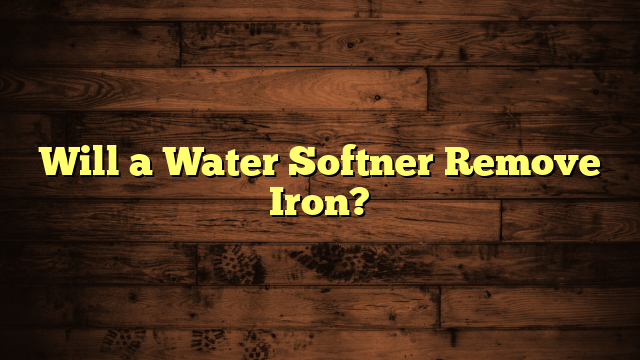Will a Water Softner Remove Iron?
You might be wondering if a water softener can effectively remove iron from your water supply. While these systems excel at tackling hard minerals like calcium and magnesium, their ability to handle iron is more complicated. You'll find that the various forms of iron in water can pose unique challenges that a standard softener isn't equipped to manage. So, what are the alternatives if you're facing iron issues in your water? Understanding the specifics can lead you to a more effective solution.
Key Takeaways
- Conventional water softeners primarily address hard water by removing calcium and magnesium, but they do not effectively remove iron.
- Ferrous iron is soluble and may not be addressed by water softeners, leading to potential staining upon oxidation.
- Ferric iron appears as sediment and requires filtration or specialized systems for effective removal, which water softeners do not provide.
- A multi-faceted approach combining water softening and iron filtration is recommended for comprehensive water treatment.
- For effective iron removal, consider alternative methods like chemical oxidation or specific filtration systems designed for iron management.
Understanding Water Softeners
When it comes to improving your water quality, understanding water softeners is crucial. These devices play a significant role in the softening process, which effectively tackles hard water issues.
Hard water contains high levels of minerals like calcium and magnesium, resulting in problems such as scale buildup in pipes and appliances. Water mineralization occurs when these minerals accumulate, affecting your home's plumbing and even your skin and hair.
A water softener works by replacing these hard minerals with sodium or potassium ions, making the water gentler and more manageable. As the hard water passes through the softening system, it encounters resin beads that attract and trap the calcium and magnesium ions while releasing softer sodium ions in their place.
This process not only enhances the quality of your water but also prolongs the lifespan of your plumbing fixtures and appliances.
Types of Iron in Water
When you think about iron in your water, it's crucial to recognize the different types you'll encounter.
Ferrous iron, for instance, is soluble and can cause staining when it oxidizes, while ferric iron is already oxidized and appears as sediment.
Additionally, iron bacteria can complicate matters by thriving in water containing iron, leading to unpleasant odors and slime build-up.
Ferrous Iron Characteristics
Ferrous iron, commonly found in groundwater, plays a significant role in water quality and treatment processes. This form of iron is soluble in water, meaning it can easily dissolve and move through aquifers, making it a common issue in many water supplies. When you test your water, ferrous iron often appears as clear or slightly tinted, especially when it's in its dissolved state.
One key characteristic of ferrous iron is its tendency to oxidize when exposed to air, converting into ferric iron, which is less soluble and can form reddish-brown precipitates. This transformation can lead to staining on fixtures and laundry, which you may have experienced firsthand.
In terms of water treatment, understanding ferrous iron's properties is vital. Since it's soluble, traditional water softeners may not effectively remove it.
You might need specific filtration systems or chemical treatments to address ferrous iron levels in your water supply. By identifying the ferrous iron content, you can make informed decisions on the right treatment options for your home's water quality.
Ferric Iron Differences
Understanding the differences between types of iron in water is crucial for effective treatment. Ferric iron, often recognized by its reddish-brown color, typically forms when ferrous iron (dissolved iron) oxidizes in the presence of oxygen. This transformation can happen in your water supply or within your plumbing system, and it's essential to know that ferric iron isn't soluble in water.
In terms of water treatment, ferric iron can be more challenging to manage than ferrous iron. Since it's not dissolved, ferric iron can lead to sediment buildup in pipes and fixtures, causing clogs and staining. You'll notice these issues in laundry, dishware, and even your plumbing fixtures, which can become unsightly over time.
To effectively remove ferric iron, you might need to consider filtration or specialized water treatment systems designed to handle particulate matter. Unlike water softeners, which primarily target dissolved minerals like calcium and magnesium, addressing ferric iron requires a different approach.
Knowing the differences between ferric iron and other types of iron in your water helps you choose the right treatment solution for your specific needs.
Iron Bacteria Presence
Many homeowners are unaware of the potential issues caused by iron bacteria in their water supply. These microorganisms thrive in environments rich in iron and can significantly impact your water quality.
If you suspect iron bacteria are present, it's essential to recognize the signs and understand the implications they bring.
Iron bacteria can lead to various problems, including:
- Unpleasant odor and taste in your water
- Brown or reddish stains on fixtures and laundry
- Clogs in pipes and plumbing systems
- Increased maintenance costs for water treatment systems
- Compromised effectiveness of water softeners
You mightn't see the bacteria themselves, but their byproducts can be very noticeable. If you notice these signs, consider testing your water.
While a water softener can help with certain types of iron, it typically won't remove iron bacteria effectively. Instead, you'll need a specialized filtration or treatment system to tackle this issue.
Addressing these bacteria promptly can ensure you maintain high water quality and prevent further complications in your plumbing and appliances.
Water Softener Limitations
While water softeners effectively remove hardness minerals like calcium and magnesium, they've limitations that homeowners should be aware of.
One major limitation is that conventional water softeners aren't designed to remove iron, which can lead to mineral buildup in your plumbing and appliances over time. If your water supply has significant iron levels, you might still face issues like staining on fixtures and laundry, despite using a softener.
Another limitation is that water softeners primarily address water hardness but don't tackle other contaminants, such as bacteria or sediment. If your water has a high concentration of these elements, a softener alone won't solve the problem.
Additionally, relying solely on a water softener can lead to an over-reliance on sodium or potassium used in the ion exchange process. This can affect your water quality, especially for those on sodium-restricted diets.
To truly address water quality issues, you may need a multi-faceted approach that combines water softening with other filtration methods. Understanding these limitations can help you make more informed decisions about your water treatment options.
How Water Softeners Work
Water softeners operate through a process called ion exchange, where hardness minerals like calcium and magnesium are replaced with sodium or potassium ions. This process significantly improves your water quality by reducing the mineral content that leads to scale buildup and other issues.
When water passes through the softener, it flows over resin beads that are charged with sodium or potassium ions. As the hard water travels through, the hardness minerals cling to the beads, and the sodium or potassium ions are released into the water.
Here are some key points to understand how water softeners work:
- Ion Exchange: The core mechanism that swaps hardness minerals for sodium or potassium.
- Resin Beads: The materials that facilitate the ion exchange process.
- Regeneration Cycle: A process where the resin beads are recharged with sodium or potassium.
- Improved Water Quality: Softer water helps prevent scale buildup in plumbing and appliances.
- Reduced Soap Usage: Softer water enhances soap effectiveness, leading to less waste.
Alternative Iron Removal Solutions
If you're looking for ways to tackle iron in your water beyond traditional methods, there are several effective alternatives.
Chemical oxidation, filtration systems, and bacterial treatments each offer unique benefits that might suit your needs.
Let's explore these options so you can make an informed choice for your home.
Chemical Oxidation Methods
Chemical oxidation methods offer effective solutions for removing iron from your water supply, ensuring it remains clear and free from unpleasant stains. By utilizing oxidation agents, you can initiate a chemical reaction that transforms dissolved iron into solid particles, making it easier to remove.
This process is particularly beneficial if your water contains high levels of iron, which can cause discoloration and unpleasant tastes.
Here are some common oxidation agents you might consider:
- Chlorine: Effective and widely available, it also disinfects your water.
- Ozone: A powerful oxidizer that eliminates iron while improving water quality.
- Hydrogen Peroxide: A safe option that breaks down iron without harmful byproducts.
- Potassium Permanganate: Useful for high iron concentrations, but requires careful handling.
- Aeration: Involves adding air to your water, which promotes oxidation naturally.
Choosing the right chemical oxidation method depends on your specific water conditions and needs.
Filtration Systems Overview
Filtration systems serve as effective alternatives for iron removal, providing a practical solution to improve your water quality. These systems utilize various filtration methods to target iron particles in your water, ensuring you enjoy cleaner, clearer water. By understanding the different types of filtration solutions available, you can select the one that best meets your needs.
Here's a quick overview of common filtration methods and their effectiveness:
| Filtration Method | Description | System Effectiveness |
|---|---|---|
| Sand Filtration | Uses sand layers to trap particles | Moderate |
| Activated Carbon | Absorbs impurities, including iron | High |
| Reverse Osmosis | Forces water through a semi-permeable membrane | Very High |
Each method has its unique benefits and limitations. For example, activated carbon is great for taste and odor removal, while reverse osmosis is highly effective for iron removal. By evaluating these filtration methods, you can determine which system aligns best with your specific requirements and budget, ultimately enhancing your water quality.
Bacterial Treatment Options
Exploring bacterial treatment options can provide an effective alternative for iron removal from your water supply.
These methods utilize specific bacteria that can oxidize dissolved iron, converting it into a solid form that can then be filtered out. This process not only addresses iron but can also enhance overall water quality.
Here are some treatment methods you might consider:
- Iron-oxidizing bacteria: These bacteria thrive in oxygen-rich environments and effectively convert soluble iron into insoluble particles.
- Biofiltration systems: These systems use layers of bacteria to break down iron, allowing for easy removal through filtration.
- Aerobic treatment: Aerobic bacteria require oxygen to survive and can effectively remove iron through oxidation.
- Anaerobic treatment: In low-oxygen environments, specific bacteria can reduce iron compounds, making them easier to filter.
- Regular maintenance: Encourage bacterial growth by maintaining your system, ensuring optimal conditions for effective iron removal.
Benefits of Water Softeners
Have you ever wondered how much easier daily tasks could be with softened water? Water softeners offer numerous benefits that can transform your household experience. From cost savings to improved taste, the advantages are compelling.
Here's a quick overview of the benefits:
| Benefit | Description |
|---|---|
| Cost Savings | Softened water reduces the need for detergents and cleaning products, helping you save money over time. |
| Improved Taste | Softened water enhances the flavor of your food and beverages, making cooking more enjoyable. |
| Longer Appliance Life | By reducing mineral buildup, softened water can extend the lifespan of your appliances, saving you from costly repairs. |
With softened water, you'll notice cleaner dishes, brighter laundry, and a more efficient use of soaps and shampoos. Your skin and hair will feel softer and healthier too. Plus, you won't have to deal with the unsightly stains that hard water leaves behind. Making the switch to a water softener can truly elevate your daily routine and provide lasting benefits for you and your home.
Choosing the Right System
Choosing the right water softener system can significantly enhance your household experience. When selecting a system, you'll want to consider various factors to ensure optimal performance and efficiency.
First, evaluate your household's water usage and hardness levels. This will help you determine the capacity and type of system that best suits your needs.
Here are some key points to consider:
- System efficiency: Look for models with high efficiency ratings to save on salt and water usage.
- Iron removal capability: If your water contains iron, ensure the system is designed to handle it effectively.
- Installation requirements: Check if you'll need professional installation or if it's a DIY-friendly system.
- Maintenance needs: Some systems require more upkeep than others; choose one that fits your lifestyle.
- Budget: Consider both the upfront cost and long-term expenses, including salt and maintenance.
Frequently Asked Questions
Can Water Softeners Remove Rust From Pipes?
Water softeners can't effectively remove rust buildup from pipes. Instead, they mainly address hard minerals. For pipe corrosion, you might need specialized solutions like chemical treatments or pipe replacement to tackle the underlying issues.
How Does Iron Affect Water Softener Effectiveness?
Iron levels in your water can significantly impact your softener efficiency. High iron concentrations can clog resin beads, reducing their ability to soften water effectively, leading to increased maintenance needs and potential system failures over time.
Will a Water Softener Improve Water Taste?
A water softener can enhance water quality by reducing hardness minerals, leading to taste improvement. You'll notice a smoother, more enjoyable flavor in your water, making it more refreshing for drinking and cooking.
Can I Install a Water Softener Myself?
Yes, you can tackle a DIY installation of a water softener if you have the right installation tools. Just ensure you follow the manufacturer's instructions carefully for the best results and efficiency.
Do Water Softeners Require Regular Maintenance for Iron Removal?
Yes, water softeners require regular maintenance to manage iron levels effectively. You should follow a maintenance schedule, including resin cleaning and salt replenishment, to ensure optimal performance and prevent buildup that could hinder their efficiency.
Conclusion
In conclusion, while water softeners effectively tackle hard minerals like calcium and magnesium, they won't remove iron from your water. If you're dealing with iron issues, consider additional filtration systems or treatments for a complete solution. A water softener can still improve your water quality, but pairing it with the right iron removal method is key. Make sure to assess your water's needs and choose the best system to ensure clean, soft water for your home.







